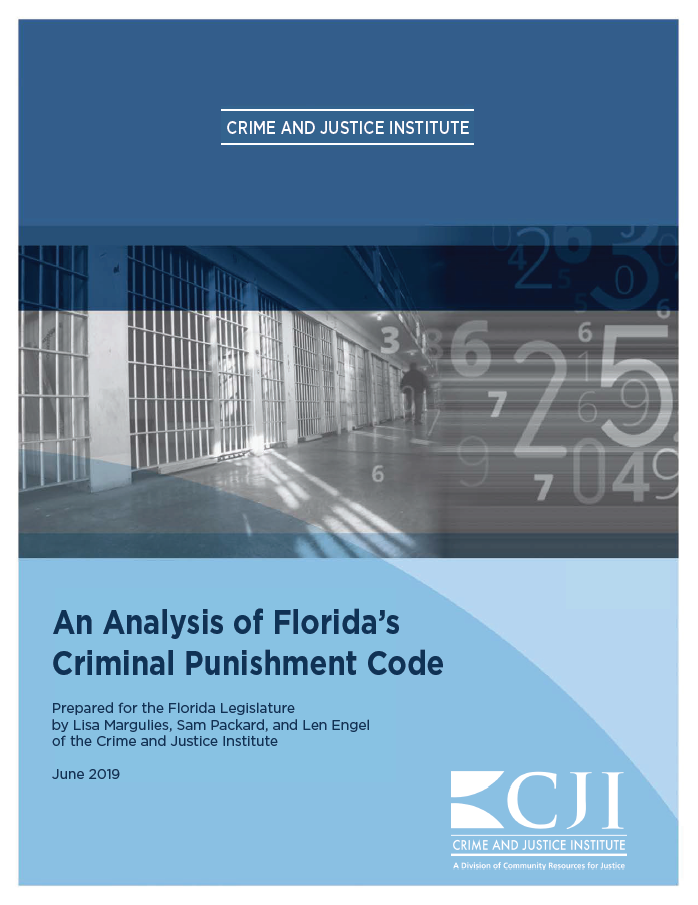
TALLAHASSEE, Florida – A June 2019 analysis from the Crime and Justice Institute (CJI) shows a path for Florida to align the Criminal Punishment Code (CPC), which has guided decision-making on criminal sentencing in the state for over 20 years, with current research on public safety and recidivism reduction.
CJI’s An Analysis of Florida’s Criminal Punishment Code shows that the CPC results in sentencing disparities across the state and an over-reliance on incarceration of lower-level offenders. The intended goals of the CPC, including fairness, proportionality, and uniformity in sentencing statewide, remain elusive yet achievable.
“Now is the time to make Florida’s criminal justice system smarter by looking at decades of research telling us what works to protect public safety and reduce recidivism,” said state Sen. Jeff Brandes, R-St. Petersburg, Chairman of the Appropriations Subcommittee on Criminal and Civil Justice. “We need to consider that, in some cases, incarceration may do more harm, especially for low-level offenders who need treatment and other services. We can do better for Floridians.”
The CJI report focuses on a particular CPC scoring range (22 to 44 points) representing lower-level offenders, for which the court has broad discretion to impose alternatives to prison. Eleven percent of the CPC scoresheets in this group received a state prison sanction—an estimated 4,500 people admitted to prison—in 2018. In this same period, average sentences for this group were 24 months, nearly twice the minimum required sentence.
Instead of sentencing uniformly across the state, judicial circuits and counties utilize prison at vastly different rates. For example, three counties in Florida sent 5 percent of 22 to 44 point scoresheets to prison in FY 2018, while two other counties sent over 30 percent each.
Since the implementation of the CPC in 1998, more research shows that incarceration is not necessarily more effective at reducing recidivism than non-custodial sanctions and may actually increase recidivism for lower-level offenders. Moreover, research demonstrates that public safety can be protected while reducing prison populations.
“Florida has an opportunity to reconsider its sentencing model in light of the data and research,” said Len Engel, CJI’s director of policy and campaigns. “Other states with similar sentencing structures have successfully employed evidence-based policies to improve their criminal justice systems. Between 2008 and 2016, more than 30 states reduced incarceration while their crime rates continued to decline, showing that you can reduce crime and incarceration concurrently and shift resources to improve law enforcement interventions, supervision, and treatment. Florida can do the same.”
“There is no question that serious violent offenders deserve to go to prison, but there are lower-level offenders who need treatment and rehabilitation, and incarceration doesn’t help,” Sen. Brandes added. “Florida can become a nationwide leader in smarter, more efficient criminal justice policies. There are examples across the state of innovative practices and policies and we should consider broadening their application.”
This analysis is the third report prepared by CJI on Florida’s criminal justice system since 2017. An Examination of Florida’s Prison Population Trends, released in 2017, focused on the cause of Florida’s static prison population, despite significant reductions in admissions to prison and a plummeting crime rate. The data indicated that the reduction in prison admissions was offset by a significant increase in both prison sentences and the amount of time served in prison. A subsequent 2018 report, Data-Driven Solutions to Improve Florida’s Criminal Justice System) provided a comprehensive set of evidence-based recommendations to hold offenders accountable, safely reduce Florida’s prison population, and prioritize public safety.
About the Crime and Justice Institute
The Crime and Justice Institute (CJI), a division of Community Resources for Justice, strives to make criminal and juvenile justice systems more efficient and cost effective and to promote accountability for outcomes. CJI takes pride in its ability to improve evidence-based practices in safety and justice agencies, gain organizational acceptance in difficult work environments, create realistic implementation plans, put these plans into practice, evaluate their effectiveness, and enhance the sustainability of sound policies and practices. For more information, visit www.crj.org/cji.